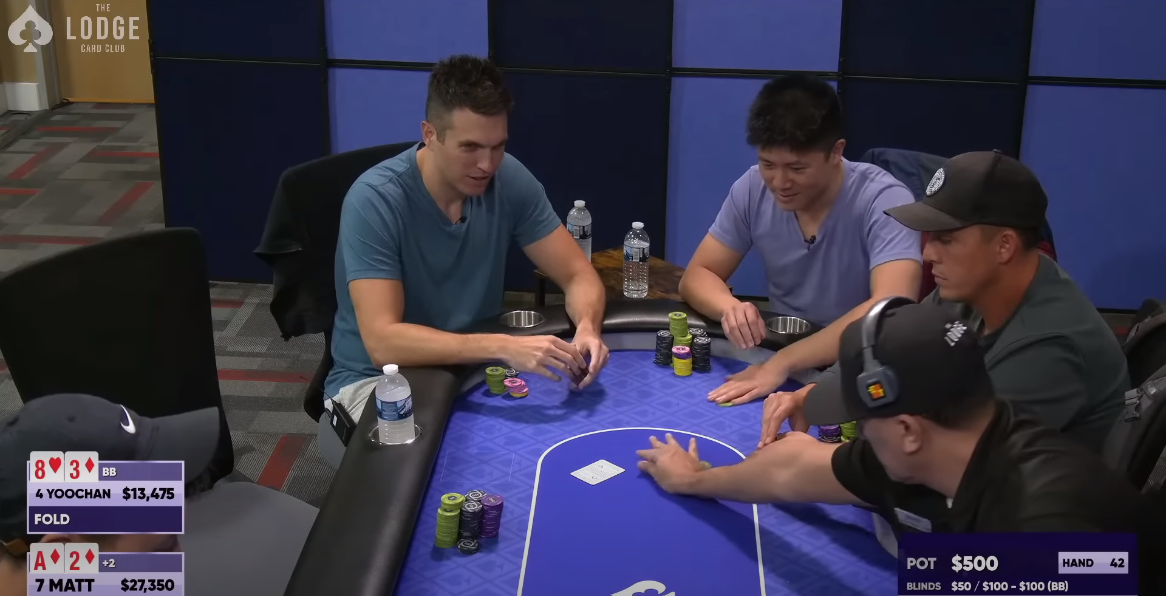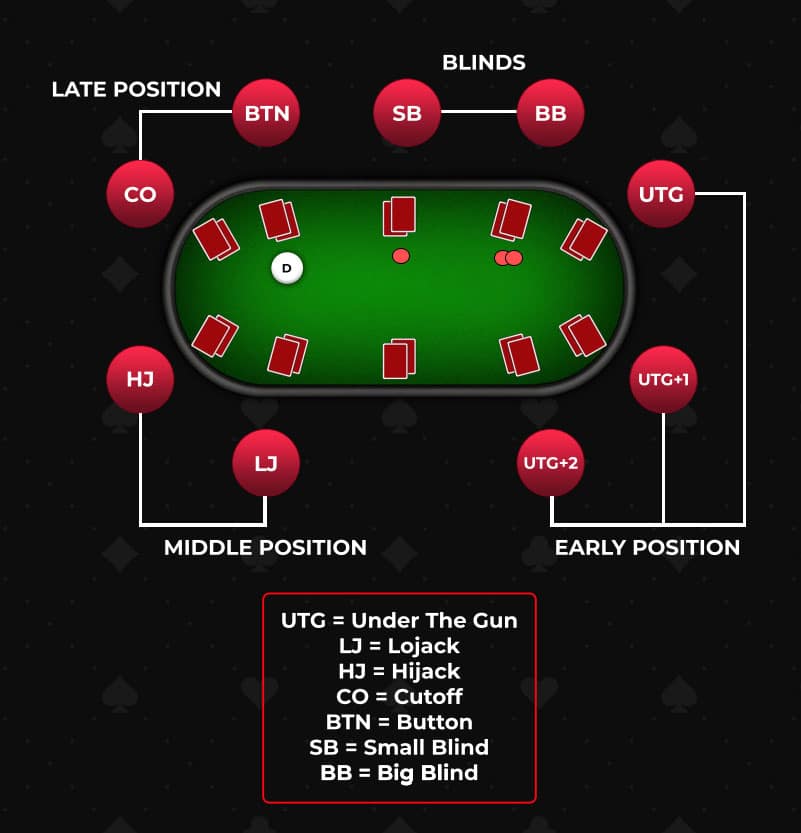The most popular poker game played at the Lodge, and around the world, is No-Limit Texas Hold’em. This poker format features the game Texas Hold’em, played with a no-limit betting structure.
The name of the game is often shortened to No-Limit Hold’em, NLHE, or NLH. No-Limit Hold’em is the game at the center of most tournaments and cash games played at poker rooms across the globe, including the World Series of Poker Main Event.
Let’s take a look at the rules of the game in this No Limit Texas Hold’em Beginner’s Guide for new players:
How To Play Texas Hold’em Poker
Texas Hold’em is one of many different games that fall under the broader term of poker. Texas Hold’em plays as a community card poker game, where a certain number of cards are shared by all players.
A Texas Hold’em game begins with each player dealt two hole cards face down. These cards are only visible to the player holding them.
Once each player has their hole cards, the first of four betting rounds begins. This first round of betting is known as the preflop round.
When the preflop round is over, the dealer put the first three of five community cards on the board. This group of three cards is known as the “flop.”
When the flop is dealt, a second betting round commences. After the flop betting round, the dealer puts a fourth community card on the table, and that card is known as the “turn,” or “fourth street.”

Another betting round takes place after the turn is dealt. When the turn round is complete, the dealer places the fifth and final community card on the board.
This card, known as the “river” or “fifth street,” precludes the final betting round. When the river round is complete, the player with the best five-card poker hand, using any combination of hole cards and community cards, wins.
Texas Hold’em uses the standard poker hand rankings to determine the winning hand.
That’s the basics of how to play poker. But let’s talk about the specific betting structure that puts the “No Limit” in No Limit Hold’em.
What Does No-Limit Mean?
In poker, the term “no-limit” can be used to describe any game that uses a no-limit betting structure. In no-limit poker games, any player can bet all of their chips at any time.
Betting all of your chips in any poker game is known as going “all-in.” All of your chips go to the middle of the table when you go all-in, and that action is also known as “jamming” or “shoving.”
Another betting structure sometimes seen in poker includes pot-limit (where the maximum bet at any time is equal to the size of the pot). Pot-Limit Omaha, another popular game at the Lodge, uses pot-limit betting rules.
Some poker games used fixed-limit betting rules. Fixed-limit games play with predetermined rules on how much you can bet in each round.
You might occasionally see Pot-Limit Hold’em or Limit Hold’em played at a poker room or tournament series. This article focuses on No-Limit Hold’em, the game that’s at the center of the action in many cash games and tournaments at the Lodge.
The Button and the Blinds
When you play poker, it’s critical to understand how the different positions operate at the table. Texas Hold’em, as well as many other poker games, uses a system involving mandatory bets that revolve around to each player at the table.
These mandatory bets are known as “blinds” and ensure that each hand begins with money already in the pot.
Most No-Limit Hold’em games include a small blind and a big blind. In cash games, the amount of the blinds are predetermined and static, staying the same at all times.
In tournaments, the amount of the blinds increase at the end of each level. Tournament levels are timed, and the increase in the blinds as the tournament goes on forces players to play hands, or see their chip stack dwindle as a result.
The cash game listings at the Lodge, and virtually all poker rooms, display the amount of the blinds for a particular game. For example, the $1/$2 No-Limit Hold’em game at the Lodge plays with a $1 small blind and $2 big blind.
When you sit at a table, you’ll notice a disc labeled “DEALER” or “BUTTON” that sits in front of a certain player in each hand. After every hand, that disc, appropriately known as the “dealer button” (or just the “button”) moves one player to the left.

The small blind position is always to the direct left of the dealer button, and the big blind always to the direct left of the small blind. In a $1/$2 game, the player in the small blind puts $1 in the pot before the hand begins, and the player in the big blind puts in $2.
Texas Hold’em Table Positions
After the players in the blinds have posted their forced bets, the dealer begins the hand. After each player has received their two hole cards, the player seated to the direct left of the big blind begins the action.
The position that begins the action in the preflop betting round is known as the “under-the-gun” position (often abbreviated “UTG”). In a nine-handed game, the player to the left of UTG is known as UTG+1, and the next player to the left is UTG+2.
Working toward the button and blinds, the next three positions are known as the “lojack,” “hijack,” and “cutoff.” Note that in a six-handed game, the lojack can be called the under-the-gun player.
Let’s take a look at how the positions are situated:

In the preflop betting round, the UTG is the first player to act, and the action moves through all of the positions until the big blind gets to act. If no player before the big blind raises preflop, the big blind gets the final opportunity to either raise, or check.
In all postflop betting rounds, the action begins with the player in the small blind. If the small blind player isn’t in the hand, the next remaining player to the left starts the action.
Table positions play a major role in a winning poker strategy. Any time you get to act last in a betting round, that position gives you a major advantage over your opponents.
Betting Rules
Nearly all poker variants play with a system of betting rules that involves the following terms:
Bet
The first aggressive betting action in a round is known as a “bet.” For example, let’s say you’re in a $1/$2 game, in the preflop round, and nobody in front of you has raised. If you put $6 in the pot, you’ve bet $6.
In the preflop round this action can also be called an open-raise or just a raise. In all postflop rounds, the first aggressive betting action is called a bet.
Call
If another player in front of you has bet or raised, you can “call” and match the amount of the bet. For instance, if someone open-raises (or “bets”) $6 preflop, you can out $6 in the pot to stay in the hand.
Raise
In any betting round, you can increase the amount of the active bet by making a “raise.” For example, if a player bets $6 preflop, you can raise to increase the amount that other players would have to put in to call.
In No-Limit Hold’em, you can raise to any amount at any time (up to the amount of chips you have in front of you.) The minimum raise amount is the size of the previous raise.
Fold
When facing a bet or raise, you can “fold” and forfeit you hand. Once you fold, you sit out of the action until the next hand.
Check
In postflop betting rounds, you can “check” if nobody in front of you has bet or raised. When you check, you add no money to the pot, and pass the action to the next remaining player. If no other players remain, the hand proceeds to the next betting round.
Poker Hand Rankings
Texas Hold’em, along with many other poker variants, use the following poker hand rankings system. The object in Texas Hold’em is to make the best five-card hand according to these rankings.
This list is organized from strongest to weakest in terms of hand strength:
Royal Flush
A royal flush beats any other five-card hand in Texas Hold’em. You make a royal flush by holding AKQJT of all the same suit.
An example of a royal flush could be A♥K♥Q♥J♥T♥.
Straight Flush
A straight flush is made from five sequential cards of all the same suit. Only losing to a royal flush, a straight flush is the second-strongest hand you can possibly make in poker.
Q♥J♥T♥9♥8♥ and 7♠6♠5♠4♠3♠ are both examples of a straight flush.
Four of a Kind
To make four of a kind, you must put together all four cards from one hand rank in the same hand. Examples of four of a kind could be A♥A♦A♠A♣7♦ or 8♥8♦8♣8♠5♠.
Full House
To make a full house, a poker player must put together three of one card rank and two of another. Holding a full house means you have three of a kind and a pair in the same hand.
Examples of a full house could include A♥A♦A♠7♣7♦ and T♣T♠T♥6♠6♥.
Note that if two or more players make a full house, the three-of-a-kind portion of the hand determines the winner.
For instance, A♥A♦A♠7♣7♦ is a better full house than 7♠7♣7♦A♥A♦.
Flush
A flush requires five cards of the same suit, no matter what the sequence. Flushes could include hands like A♠J♠7♠4♠2♠ and T♥7♥5♥3♥2♥.
If two flushes go head to head, the best high card wins. For example, A♠J♠7♠4♠2♠ (an ace-high flush) beats T♥7♥5♥3♥2♥ (a ten-high flush).
Straight
To make a straight, you must put together five sequential cards. Examples of straights could include A♠K♣Q♠J♦T♣ (known as a “broadway straight”) or 9♠8♠7♣6♥5♦.
Three of a Kind
Three of a kind requires three cards of the same hand ranking. Examples include A♥A♦A♣6♣5♠ and T♥T♣T♣4♦3♠.
Two Pair
Two pair hands put two distinct pairs in the same hand. For example, A♥A♣T♥T♦5♣ and 8♠8♦7♠7♦2♣ are examples of two pair hands.
Pair
A pair requires you to put together two cards of the same hand ranking. A♥A♣T♥8♦3♣ and 9♥9♣6♥5♦2♣ are examples of pair hands.
High Card
If your five-card hand doesn’t include any of the made hands on this list, you have a high-card hand. High-card hand strength is determined by the highest-ranking card in the hand.
For example, A♥K♣T♥8♦5♣ is an ace-high hand, and 9♥8♣5♥3♦2♣ is a nine-high hand.

No-Limit Hold’em Example Hand
Let’s go through an example hand, beginning to end.
Suppose you sit down for the $1/$2 No-Limit Hold’em game at the Lodge. In this game, the $1/$2 denotes a game with a $1 small blind and a $2 big blind.
The max buy-in for $1/$2 NLHE at the Lodge is $300, and the minimum is $100. So when you sit down in the game you must put an amount of money that’s at least $100 and a max of $300 in front of you on the table.
You decide on the maximum buy-in of $300, and find yourself sitting in the position to the direct left of the big blind. That puts you in the under-the-gun position. Nine total players (including you) are sitting in the game.
The dealer gives each player two cards face down, and as the UTG player you’re first to act preflop. You look down at a solid starting starting hand:
A♣Q♣
The minimum bet in this case is $2, which would constitute a call (matching the amount of the big blind). You have the option to either make the $2 call, raise (increasing the size of the active bet) or fold (surrender your hand and forfeit any opportunity to win the pot.)
With your ace-queen suited, you’re looking to raise, and you raise to $10. The next player to act then gets the option to either call (match the $10 raise), raise (increasing the size of the active bet), or fold. That player (in the position known as UTG+1) folds.
The next three players (position UTG+2, lojack, and hijack) all fold as well. That puts the action on the cutoff player, who calls the $10 raise.
The player on the button also calls the $10 raise. The small blind folds, but the big blind player decides to raise to $60.
That puts the action back on you, and you can either call the $60 (adding $50 to your original bet), raise to a larger amount, or fold. With ace-queen suited, you decide to call. Both the cutoff and the button fold.
The preflop action leaves you going heads-up against the player in the big blind. The action proceeds to the flop betting round with $141 in the pot.
The dealer puts three cards face-up on the table:
A♠8♣2♥
This rather favorable flop gives you a pair of aces. The big blind player is first to act in all postflop betting rounds against the UTG position. In the flop betting round, the big blind player can either check (bet nothing and pass the action to you), or bet. If your opponent bets, you can either call, raise, or fold.
The big blind elects to check, and you bet $70. The big blind calls, closing out the flop betting round.
You and your opponent in the big blind head to the turn, with $350 in the pot. You have $180 in chips left remaining going to the next betting round.
The dealer puts the turn card on the board:
3♥
The three of hearts hits the felt, and your big blind opponent checks. You decide to go all-in for your remaining $180. Your opponent calls.
Those actions close out the turn betting round. The dealer puts the fifth and final community card, known as the river, on the board:
K♠
The king of spades hits the board. Neither player can bet anymore in this final round (because you went all-in on the turn and got called), and it’s time to go to showdown, where players must show their hand, or muck without showing and automatically forfeit the hand.
The hands show like this:
Your Hand: A♣Q♣
Big Blind: A♥5♥
Both you and your opponent have a pair of aces, but your queen kicker makes your hand the winner. You collect the $600 pot, and the next hand begins.



